Ron Edwards' Trollbabe by GimpInBlack
Introduction
Original SA post
So I've been playing a fair bit of
The Banner Saga
lately, and the giant, horned Viking-ness of it all has got me thinking about :
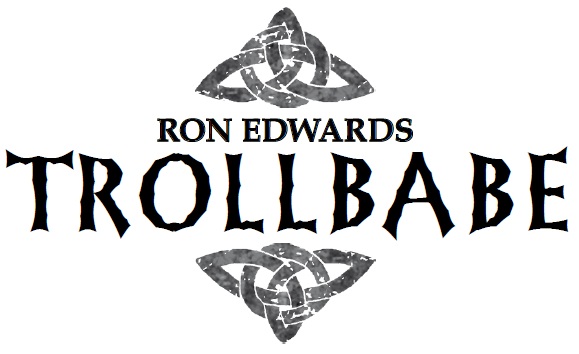
Trollbabe
is Ron Edwards' game of... err... trollbabes wandering around, having cool adventures, and making new friends and enemies. The first edition was published in 2002, with a revised version in English in 2009 that--okay, look, I know the title's kind of goofy and the premise hits some people about as well as the phrase "
Apocalypse World
has sex moves," but goofy title and Ron Edwards' sometimes difficult prose aside, there's a really neat little game here.
Right. Sorry. Where was I? Ah, yes, the revised version in 2009. Funnily enough the revision was, I believe, prompted by the translators of the Italian edition of the game, who asked so many questions about the rules and added so many clarifications and examples that Edwards put the answers into the English version too. For reference, the original
Trollbabe
was about 47 pages long, the revised pdf is 110 pages. We'll be looking at the revised version here. (The Italian version also has some
gorgeous
illustrations I'll be peppering through this review.)
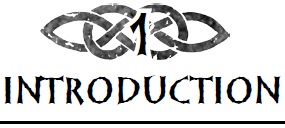
So just what the hell is a Trollbabe?
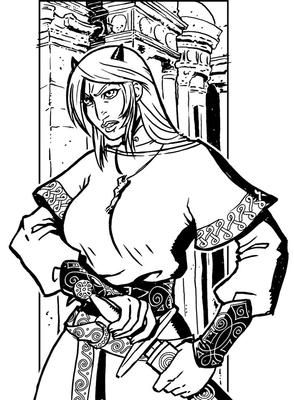
This is.
Well, they're big, for starters. 6'6" on the short end, and solidly built and--
Ron Edwards posted:
a trollbabe is a big woman, no little aerobicized butts allowed.
Goddammit Ron you are not helping my case here. Anyways, trollbabes are big, and moreover they're strong --even the weakest is a match for the strongest human out there. We're told they have mostly-human features and lack the "characteristic trollish body hair and posture." They do have horns, though--big curly sheepy horns, or little pointy goaty horns, or broad heavy cow-y horns, whatever. Not antlers, though. Antlers aren't horns. Trollbabes have horns.
It doesn't really matter where trollbabes come from; sure, maybe they're troll/human hybrids, but maybe they're not. Maybe they're just born into one or the other races sometimes, or they're the product of magic, or hell, don't even bother explaining where they come from. All that matters is that they stand outside both societies but are bound to each of them, and that the PC trollbabes are the only ones in the world.
As for that world, it's presented in similarly broad strokes. Geographically, it's Norse-pastiche: lots of deep-cut fjords, low mountains covered with pine trees, frozen rivers and harsh winters. There's magic and monsters, but it only exists as an external reflection of real-life, personal conflict. The villagers aren't stalked by a hungry draugr because an evil overlord summoned the hungry dead from their graves to rule the world, but because the dead warrior's best friend left him to die on the battlefield and lied about what happened to conceal his cowardice.
The humans in this world are likewise Norse-alikes (albeit with a flavoring of Celtic, Baltic, or Icelandic influences): Mostly Iron Age farmers, fishermen, and herders, they tend to live in small fortified communities or lonely homesteads.
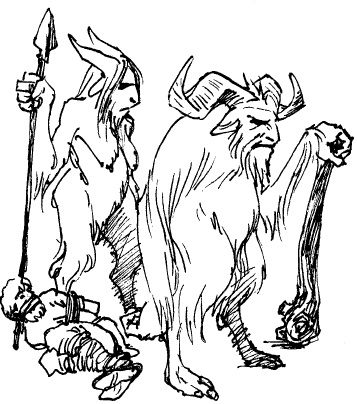
TROOOOOOLLLLLLLLLLLLL!!!
Trolls, on the other hand, are massive, shaggy, horned beings that walk on their toes, work powerful natural magic, and occasionally eat people. They tend to live in bleak, gloomy places far from human habitation, but we all know how well that tends to work out.
Aside from Norse mythology, the Icelandic Sagas, and related fantasy literature, Trollbabe is heavily indebted to the underground comix scene of the 1970s. In particular, the aesthetic of Vaughn Bode seems to have had a big impact. Link NSFW for lots of cartoon nudity, but unlike a lot of fantasy art from the same period, there's a sort of... I dunno, innocence to a lot of it? The art in Trollbabe definitely reflects this, being all black-and-white line art.
And that's all we get as far as a setting, barring a few small maps that could be used to kickstart the story. Even those maps just have a few placenames written on them--it's on us as players to fill in the blanks. Trollbabe is very much a showcase for Ron Edwards' "Story Now" design philosophy, and the influence it has on later games like Dogs in the Vineyard is apparent here. (In fact, Vincent Baker is credited as an interior artist on this book, though I'm not sure which pieces are his.)
We round out the chapter with a discussion of scale. Scale is the level on which the story operates, both in terms of the dramatic stakes and in terms of what kind of things a trollbabe character can do. Games always start at the personal scale, so the stakes of the story will be the well-being of one or two people and the trollbabes' actions can only directly affect one or two people at a time. After each story, a player ( any player) can step the scale up by one level, escalating the larger story of the game. After a few sessions, the PCs might be fighting for the fate of an entire kingdom, fighting an army single-handedly, or casting spells that bring nourishing rain to a whole valley. The stakes never go back down, though, so increase with care; you might find yourself outgrowing the things you care about.
Next Time: We'll learn how a single number is all we need to make a trollbabe and talk about the (minimal) adventure prep a game of Trollbabe needs.
Getting Started
Original SA post
Last update we got a brief overview of Trollbabe , its world, and the influences that inspired it. This time we're going to start learning how to actually play the game. Now, a lot of RPGs frontload you with rules and character creation and whatnot, only to relegate "how to run this game" to a chapter somewhere near the back. Trollbabe is organized a little bit differently: the chapters are presented roughly in the order that you might encounter their topics during an actual game, and each chapter covers the players and the GM equally. So the next chapter covers not only character creation, but also how to prepare a Trollbabe adventure. It's a good layout for a book as small and rules-light as Trollbabe , and it makes it pretty easy to learn the whole game as you go.
Chapter 2: Getting Started
Trollbabe is a pretty prep-light game. It's not full-on no prep, like Apocalypse World , but I'd say it's lighter than, say, Dogs in the Vineyard. Maybe about as prep-heavy as TechNoir. We're told it should take about 40 minutes, total, between all the players creating trollbabes and the GM creating one or more adventures, and my limited experience is that that number feels about right.
(Yes, I said one or more adventures. We'll get to that.)
Remember how last update I said that you only need a single number to create a Trollbabe character? Here's how that works. All conflicts in Trollbabe boil down to one of three categories: Fighting, Magic, or Social. A trollbabe has a Number, ranging from 2 to 9, that determines how good she is at each thing. To Fight, you have to roll under the number (on a d10). To do Magic, you have to roll over the number. To be Social, you have to roll whichever range is smaller, but including the number. So if, for example, our trollbabe character's number is 4, she successfully Fights on a roll of 1-3, Magics on a roll of 5-10, and Socializes on a roll of 1-4.
There are a few more permutations that we'll get into in the Conflicts chapter, but this right here is the hot-rod engine at the heart of Trollbabe. It's fast, it's simple, and it reminds you just how much trollbabes are caught between two extremes. It also reinforces the fact that trollbabes are outsiders--with one exception, no matter what her Number is, her Social ability is always going to be her second-best resort for solving problems. (The exception, of course, is if her Number is 5, and we aren't told whether to roll over or under for Social actions in that case, so... I guess it's player's choice.)
This is also, incidentally, the first place where you really start to see the hacking potential of Trollbabe. As long as you can break the actions in your setting down into three strong, iconic types, Trollbabe will work beautifully.
So, on to creating a trollbabe. It's a simple, five-step process, and to illustrate it I'm going to be creating this trollbabe, who I found on the deviantart gallery of one of the Trollbabe artists:
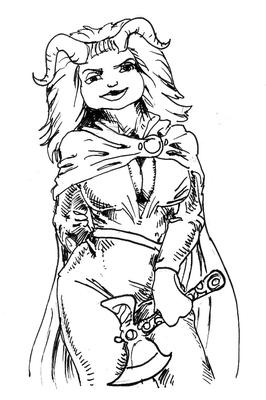
I'm going to call her Hrefna, I think.
Step One
Choose the character's Number. Pretty straightforward, right? Any number between 2 and 9 is perfectly valid. This is the first and last mechanical choice you'll be making.
Hrefna looks like a fairly physical type, so I'm thinking her Number is 7. That means she successfully fights on a 1-6, Magics on 8-10, and Socializes on 7-10.
Step Two
Next we get a list of "impressions" for each of the three action types. These are roleplaying aids and character focus; they don't have any mechanical impact or determine what your trollbabe can or can't do, but they give you a guide on how to play your character and how NPCs might react to her. Just like Apocalypse World's Look options, we pick one from each list. No ad-libbing here.
Looking over the lists, I think Hrefna gives the impressions of "hand-held weapons" (for Fighting), "human magic" (for Magic; we'll learn more about the differences between troll and human magic later), and "feisty" (for Social--just look at that smirk).
Step Three
Here we get a little more freedom of description, as we're instructed to describe our trollbabe's hairstyle and color and the size and shape of her horns. It might seem like a small detail, but Trollbabe is designed to feel very visual, and these two aspects of the character's appearance are key.
Hrefna has straight red hair swept back from her face, a little longer than shoulder-length. Her horns project out sideways from her skull and are curved like a buffalo's.
Step Four
Now we describe two small items she carries, one human and one trollish. These aren't necessarily valuable or useful, but they're important to her in some way. This is also where we describe her clothes, again based on either human custom, trollish custom, or some combination of the two.
Hrefna carries a smooth stone with a hole through the middle; trollish lore says you can see spirits through it. She also wears a golden cloak-pin in the shape of the sun, a gift of thanks for saving the life of the thane's eldest son. She dresses in human clothing: buckskin leggings and a long-sleeved tunic, with fur-lined mittens and a heavy green cloak in bad weather.
Step Five
Finally, my personal favorite step: Take a look at the map your GM has prepared for you and point at a cool-sounding spot. Your trollbabe's adventure begins with her, hiking through the wilderness, toward that spot. It's totally okay to pick a spot nowhere near the other PCs if you want. Either way, it makes sure every game kicks off with a strong, iconic image. You can also detail out any other equipment your trollbabe carries at this stage if you really want to, but it's not terribly important. Just remember that the game begins with your trollbabe traveling somewhere on foot.
Because I'm a lazy SOB, I'm stealing a piece of the map from The Banner Saga for this demonstration.Â
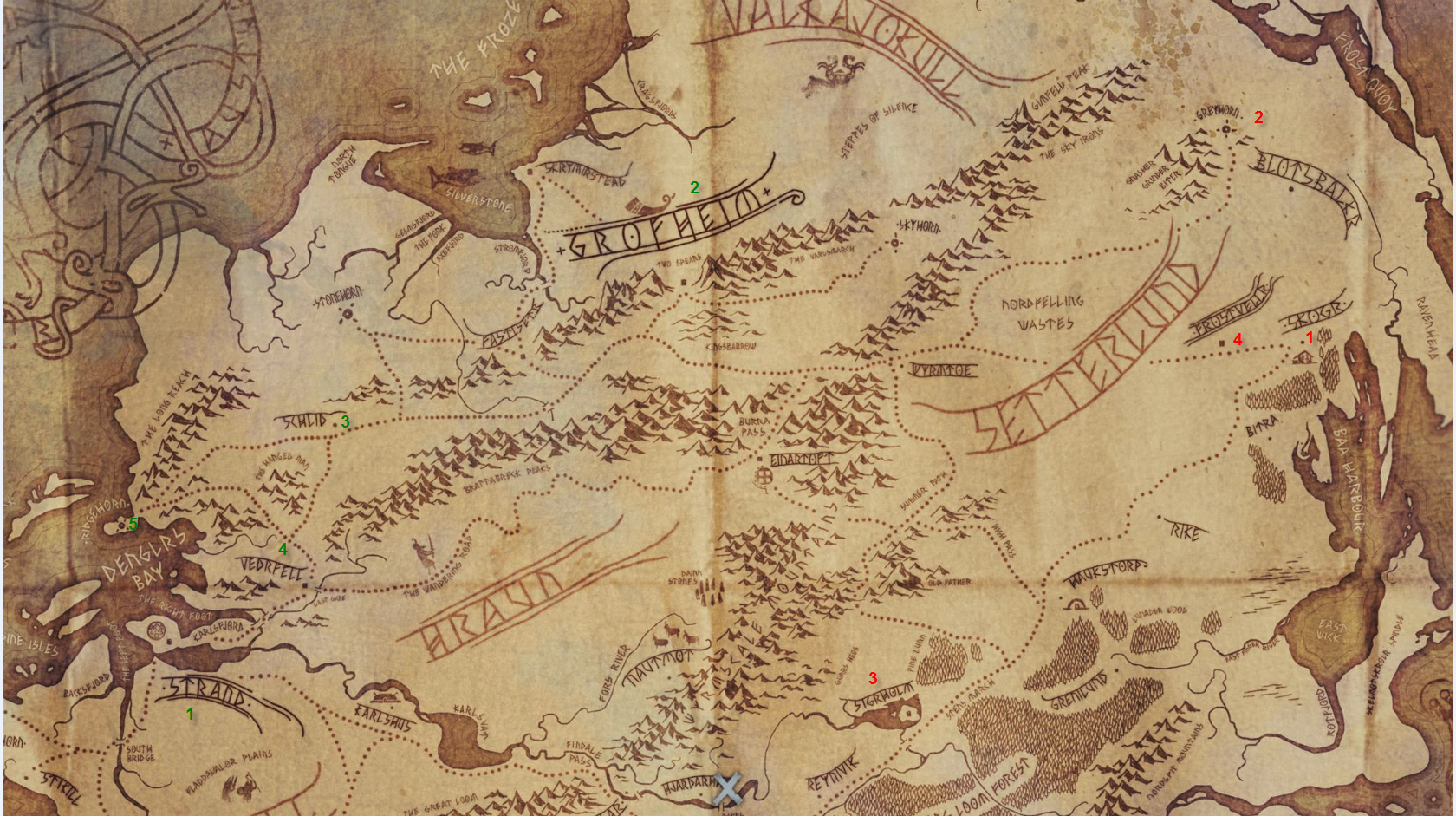
Looking it over, I think "Kingsbarrow" sounds like a cool place to be headed, so that's where Hrefna's story will begin.
And that's how you make a trollbabe. It's a really simple, easy process that should give you a pretty decent sketch of a character torn between the two halves of her nature. In keeping with Ron Edwards' "Story Now!" philosophy, we'll discover a lot more about who the character is in play, rather than writing out a long, detailed backstory and personality profile.
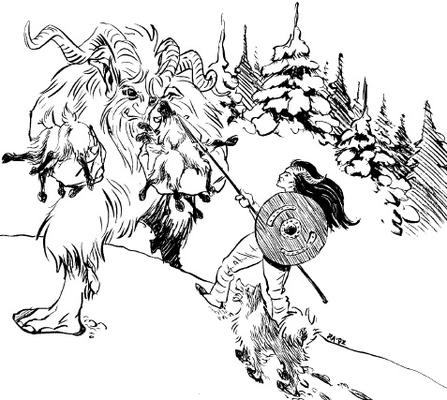
Stakes: four sheep.
Next up is the GM's section of Getting Started. Once all of your players have created trollbabes and decided where they're headed, it's your job to prepare an adventure at each location. Depending on how many PCs you have and how much they think like a traditional RPG "adventuring party," that might be anywhere from one to three or four adventures. Luckily, adventure prep boils down to answering a few simple questions to set up the stakes of the story, then turning the trollbabes loose to see what happens. No detailed synopses or plot maps; just an untenable situation the trollbabe is about to barge into and set on a collision course with drama.
First up is the "where" of the adventure. The players have done the basics of this part for you, so all you have to do is put a little detail onto the name on the map. Brainstorm some visuals, some sounds and smells, and think about what sorts of scenarios the trollbabe might encounter there.
Switching hats, I'm now prepping Hrefna's first adventure. I already know she's headed to Kingsbarrow, which looks like a pretty desolate place to me. I figure it was the site of a great battle long ago, and ever since the King of Grofheim was buried on the battlefield, it's been traditional to build royal tombs in that haunted place. I'm thinking blasted moorland, incessant wind that seems to carry voices from beyond the grave, and a haze in the air that cuts visibility to almost nothing.
Once we've got the where, we need to look at the "who." For a Trollbabe adventure, no matter how desolate the place, no matter how much the trollbabe just wants to be left alone, there's always someone there. Might be humans, might be trolls (but a mix is usually best), might be a whole kingdom or just one guy, but somebody's there and doing something.
I think there's a funeral procession from Skyhorn, bringing the body of their king to be laid in his barrow. I think about trolls, but decide instead that the ghosts of the warriors who died in the battle decades ago roam these hills, denied entry to the afterlife for some reason.
Next up comes the "what." This is where we start to get formal and nail down the Stakes of the adventure. There's someone, or something, that one or more characters want. That's going to be the fulcrum for the drama of the adventure, so it needs to be significant: life or death, victory or defeat, salvation or exile, that kind of thing. Stakes are always set at the same Scale as the adventure--remember we talked about Scale in the last update? Stakes are always a concrete thing , not a goal. "To save the troll's life" isn't a Stake, the troll himself is. Stakes likewise never say anything about the trollbabes themselves--how they react to the stakes is up to the players.
The real secret here, though, is that exactly what the stakes are don't matter. As long as you pick something that can reasonably be pulled in two (or more, but two is best for ease of understanding) mutually-exclusive directions and fill the adventure with people who won't rest until the stakes go their way, you're golden. Like Ron says, if you're still stuck thinking about this after five minutes, you're taking too long.
An obvious Stake that presents itself is "the ghost-warriors;" will they make it to Valhalla or be trapped forever on earth? Since this is Hrefna's first adventure, though, the Stakes are "personal." One, maybe two people at most. I mentally revise the time frame of the battle that was fought here and decide that the Stakes are one old man in the King's funeral procession, a veteran of the battle. Will he survive or be slain by the angry ghosts?
Lastly, we revisit the "who" and nail down a few specific characters. Likely we've already done a lot of this just by figuring out our Stakes, but now we can formalize that and jot down a few (very brief) notes about who's involved. It's also a good idea to jot down a list of names that we can pull from as new characters are introduced, and maybe sketch out a map of the immediate area.
Obviously we have the old veteran, who I'll call Asbjorn. I think he was a craven and his cowardice got a lot of his battle-brothers killed. Those ghosts now want him dead for his crimes. I figure we need at least one other member of the procession to voice support for throwing the old man to the ghosts once it comes out what he did. I'll call him Dagr, and say he's the King's son and heir-presumptive, but he hasn't been approved by the council of thanes yet. Finally, the ghosts get a "face character" in the form of Grimalf, the ghost of Asbjorn's closest friend. For added injury, I think Asbjorn ended up marrying his widow when he returned home. I'll call her Torleiva, and say that maybe she's with the funeral party as well. With that, and a handy list of names culled from Kate Monk's Onomastikon , I'm ready to see how Hrefna deals with this boiling pot of drama.
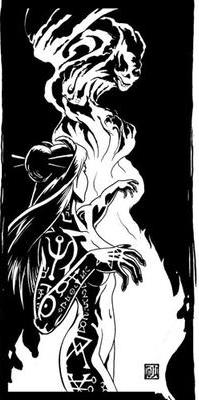
G-g-g- ghost!
And that's it. I'll let Ron himself sum it up:
Trollbabe posted:
Consider what you’ve prepared so far and think about what might happen when characters get desperate. Typically, that means various permutations of property, family, and romance, which in practice become issues of theft, fraud, feud, and murder.
Therefore, Trollbabe adventures often take place in seething cauldrons of social tension. If they haven’t exploded already, then they’re about to.
All that said, however, I can’t overemphasize: do not prepare a “story.” No climax, no planned confrontation at the end, no “mission,” no nothing. When I say “no more” for prep, beyond the list of material presented here and only to the sketchy extent presented here, I really mean it.
Next Time: We'll look at how scenes are structured and how conflicts work.